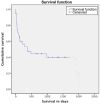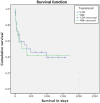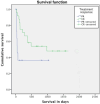Feline mediastinal lymphoma: a retrospective study of signalment, retroviral status, response to chemotherapy and prognostic indicators
- PMID: 24366846
- PMCID: PMC11164164
- DOI: 10.1177/1098612X13516621
Feline mediastinal lymphoma: a retrospective study of signalment, retroviral status, response to chemotherapy and prognostic indicators
Abstract
Historically, feline mediastinal lymphoma has been associated with young age, positive feline leukaemia virus (FeLV) status, Siamese breed and short survival times. Recent studies following widespread FeLV vaccination in the UK are lacking. The aim of this retrospective multi-institutional study was to re-evaluate the signalment, retroviral status, response to chemotherapy, survival and prognostic indicators in feline mediastinal lymphoma cases in the post-vaccination era. Records of cats with clinical signs associated with a mediastinal mass and cytologically/histologically confirmed lymphoma were reviewed from five UK referral centres (1998-2010). Treatment response, survival and prognostic indicators were assessed in treated cats with follow-up data. Fifty-five cases were reviewed. The median age was 3 years (range, 0.5-12 years); 12 cats (21.8%) were Siamese; and the male to female ratio was 3.2:1.0. Five cats were FeLV-positive and two were feline immunodeficiency-positive. Chemotherapy response and survival was evaluated in 38 cats. Overall response was 94.7%; complete (CR) and partial response (PR) rates did not differ significantly between protocols: COP (cyclophosphamide, vincristine, prednisone) (n = 26, CR 61.5%, PR 34.0%); Madison-Wisconsin (MW) (n = 12, CR 66.7%, PR 25.0%). Overall median survival was 373 days (range, 20-2015 days) (COP 484 days [range, 20-980 days]; MW 211 days [range, 24-2015 days] [P = 0.892]). Cats achieving CR survived longer (980 days vs 42 days for PR; P = 0.032). Age, breed, sex, location (mediastinal vs mediastinal plus other sites), retroviral status and glucocorticoid pretreatment did not affect response or survival. Feline mediastinal lymphoma cases frequently responded to chemotherapy with durable survival times, particularly in cats achieving CR. The prevalence of FeLV-antigenaemic cats was low; males and young Siamese cats appeared to be over-represented.
© ISFM and AAFP 2013.
Conflict of interest statement
The authors do not have any potential conflicts of interest to declare.
Figures




References
-
- Malik R, Gabor LJ, Foster SF, et al.. Therapy for Australian cats with lymphosarcoma. Aust Vet J 2001; 79: 808–817. - PubMed
-
- Mooney SC, Hayes AA, MacEwen EG, et al.. Treatment and prognostic factors in lymphoma in cats: 103 cases (1977–1981). J Am Vet Med Assoc 1989; 194: 696–702. - PubMed
-
- Mooney SC, Hayes AA, Matus RE, et al.. Renal lymphoma in cats: 28 cases (1977–1984). J Am Vet Med Assoc 1987; 191: 1473–1477. - PubMed
-
- Podell M, DiBartola SP, Rosol TJ. Polycystic kidney disease and renal lymphoma in a cat. J Am Vet Med Assoc 1992; 201: 906–909. - PubMed
-
- Vail DM, Moore AS, Ogilvie GK, et al.. Feline lymphoma (145 cases): proliferation indices, cluster of differentiation 3 immunoreactivity, and their association with prognosis in 90 cats. J Vet Intern Med 1998; 12: 349–354. - PubMed
MeSH terms
Substances
LinkOut - more resources
Full Text Sources
Other Literature Sources
Medical
Research Materials
Miscellaneous

